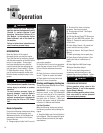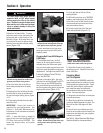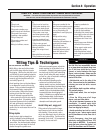
Section 4: Operation
SLOW GEAR, LOW BELT RANGE
For:
• Tilling in sod.
• Tilling in hard clay.
• Tilling under standing corn
-
stalks in tough soil conditions.
• Tilling under cover crops.
• Preparing a deep seedbed.
• Tilling in stony soil.
• Tilling under residues and
organic matter.
• Mixing in fertilizers, manure.
SLOW GEAR, HIGH BELT RANGE
For:
• Tilling in sod or hard clay.
• Tilling under standing corn
-
stalks (slow, steady speed
allows time to shred stalks).
• Tilling under cover crops
(best wheel speed and belt
speed range in most soils).
• Preparing seedbeds (best
speed choice in most soils).
• Tilling in stony ground.
• Building raised garden beds.
• Mixing in fertilizer.
• Using hiller wings in hard
soil.
• Mixing fertilizer and manure.
• Tilling residues and organics.
FAST GEAR, LOW BELT RANGE
For:
• Going over seedbed for the
last time before planting crops.
• Covering over seeds in wide
row or plot planting (lift
handlebars to avoid going too
deep).
• Hilling and furrowing.
• Making raised beds.
• Cultivating (lift handlebars to
avoid going too deep).
• Tilling large areas.
• Tilling organic matter in.
• Cultivating between raised
beds with optional hiller/
furrower attachment.
FAST GEAR, HIGH BELT RANGE
For:
• Preparing seedbeds for
planting.
• Covering seeds with less need
to hold up the handlebars.
• Cultivating (tiller travels faster,
rides higher on the soil; allows
engine RPM to be reduced;
handlebars don’t have to be
raised).
• Keeping large areas tilled and
cultivated in the summer.
• Tilling organic matter under.
• Moving tiller quickly.
• Cultivating between raised
beds using the optional hiller/
furrower.
TABLE 2-4: WHEEL SPEED AND BELT RANGE SELECTION GUIDE
IMPORTANT — For correct wheel speed and belt range choices when using attachments or accessories
other than tines, read the Owner/Operator Manual provided with the attachment or accessory.
Let the tiller do the work
• While tilling, relax and let the wheels
pull the tiller along while the tines do
the digging. Walk on the side that is not
yet finished (to avoid making footprints
in the freshly tilled soil) and lightly, but
securely grip the handlebar with just
one hand (Figure 4-4).
• Avoid pushing down on the handlebars
in an attempt to force the tiller to dig
deeper. Doing so takes the weight off
the powered wheels, causing them
to lose traction. Without the wheels
helping to hold the tiller back, the
tines will attempt to propel the tiller
– often causing the tiller to skip rapidly
across the ground. (Sometimes, slight
downward pressure on the handlebars
will help get through a particularly
tough section of sod or unbroken
ground, but in most cases this won’t be
necessary.)
Tilling depths
• Avoid trying to dig too deeply too
quickly, especially when busting sod
or tilling soil that hasn’t been tilled for
some time. Use shallow depth settings
(only an inch or two deep) for the first
passes through the garden area.
With each succeeding pass, adjust the
depth regulator to dig another inch or
two deeper. (Watering the garden area a
few days prior to tilling will make tilling
easier, as will letting the newly worked
soil set for a day or two before making a
final, deep tilling pass.)
• When cultivating (breaking up the
surface soil around plants to help
destroy weeds), use very shallow depth
settings to prevent injury to plants whose
roots often grow close to the surface. If
needed, lift up on the handlebars slightly
to prevent the tines from digging too
deeply. Cultivating on a regular basis not
only eliminates weeds, it also loosens
and aerates the soil for better moisture
absorption and faster plant growth.
Avoid tilling wet, soggy soil
Tilling wet soil often results in large,
hard clumps of soil that can interfere
with planting. If time permits, wait a
day or two after heavy rains to allow the
soil to dry before tilling. Test the soil by
squeezing it into a ball. If it compresses
too easily, it is too wet to till.
Tilling Tips
&
Techniques
To help avoid personal injury, be aware
that the tiller can unexpectedly bounce
up or jump ahead and propel away from
you if the tines strike hard or frozen
ground, or buried obstacles like large
stones, roots or stumps. Always use the
following precautions to help maintain
control of the tiller:
• Walk behind and to the side of the
tiller. Use one hand on the handlebars,
relaxing your arm but with a secure
hand grip.
• Use shallow depth regulator settings.
Till gradually deeper.
• Use slower wheel, tine and engine
speeds.
• Clear the tilling area of all large
stones, roots and other debris.
• Do not put downward pressure on the
handlebars. If needed, apply slight
upward handlebar pressure to keep the
tines from digging too deeply.
• Avoid contacting hard soil or sod at
the end of a row – reduce engine speed
and lift handlebars to raise tines out of
the soil.
• In An Emergency, stop tines and
wheels by moving Wheels/Tines/ PTO
Drive Lever to NEUTRAL. If you cannot
reach the lever or have lost control, Let
Go Of The Handlebars and All Controls.
WARNING


















